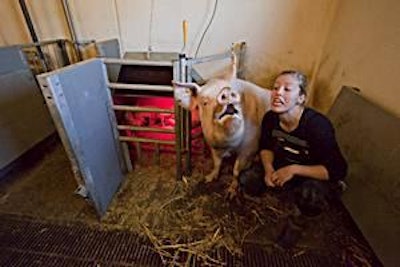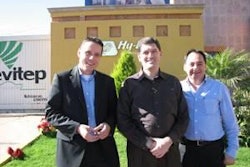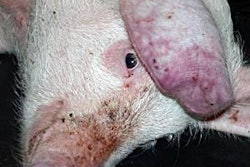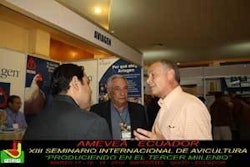
The Danish pig industry is developing a practical, cost-effective and animal welfare friendly loose housing system for farrowing and lactating sows that is safe for piglets, stockmen and women.
Spurred on by a group of Danish pig farmers, the industry wants a crate system that will allow it to satisfy demands of the animal welfare lobby, while still remaining competitive in the international pigmeat markets.
Such a system could be a useful marketing tool if the Danish Agriculture and Food Council’s team of researchers comes up with the right answers, and several multinational supermarkets have expressed interest in the project.
“We hope this ongoing project, which started with the first prototype crate eight years ago, will lead to increased milk uptake for piglets, with more even piglets at weaning, as well as an improved public image and better motivation for staff,” says senior project manager, Vivi Aarestrup Moutsen. “The key factor is to enable the sow to take better care of more of her own piglets.”
Real-world testing
Speaking in Copenhagen, Moutsen said her team has already come up with a number of different designs, which are being tested in practical conditions on pig farms across the country. The designs will be adapted until they develop a system that achieves the best results.
The trick is to provide a pen big enough for the sow to lie down comfortably and to get up to urinate and defecate. It also must include a protected area for the piglets and also provide farm workers with easy and safe access to both the sow and her piglets.
This means the pens need to include a partly solid floor and a creep area, as well as nesting and materials for rooting and enrichment. But, the question was whether the creep area should be in a corner, or along the aisle for easy access for staff.
There also are questions on the size of the pen, hygiene, the slope of the floor to prevent rolling, the siting of the dunging, feeding and resting areas, as well as staff safety. Other challenges include piglet mortality and sow handling.
Sow behaviour
In an attempt to achieve the best results, the team studied video recordings of sows to see how much space they need, and to study their movements and how the piglets react to these moves.
At the end of 2008, the team had 327 pens out being tested on farms and hoped to have another 600, at least, on trial before the end of 2009.
“We still have some challenges, including piglet mortality, and we are trying to get as many herds as possible to take part in these trials to help us come up with the answers more quickly,” says Moutsen. “We want our pens to be as simple as possible, while making everything easier to manage. At the same time, we are hoping to develop a system that will actually encourage farmers to switch over to them in preference to the traditional farrowing crate.”
Danish producer weighs in
One of the farmers who is testing some of the new farrowing pens, Ole Haahr, says, “They are OK, but they do require more management and there is still about 20% piglet mortality.”
Haahr rears weaners up to 30kg at Nolev Ostergard Farm, Nolev, Denmark, before selling them on for finishing. Most of his sows farrow in crates, which have adjustable bars and are opened up after four days on welfare grounds. However, he is keen to invest in new pens, as long as the design can be tweaked to reduce crushing levels.
His head stockwoman, Tove Baunsø Sørensen, who spent some time working with outdoor units before moving inside, agreed. “While it is a great idea, it doesn’t really work yet. It is good to see the sows loose housed, but I also think it needs a bit more development.”
Looking to the future, Moutsen admitted it could take some time before loose housing for farrowing and lactating sows was accepted by a majority of Denmark’s farmers.
However, she is convinced the work is worthwhile and would benefit the industry in the long term. Her team is working with researchers in the UK where a similar research project looking at welfare-friendly alternatives to the farrowing crate has just got under way with the building and evaluation of prototype designs.
UK research
Funded by Defra, and costing a total of £690,000 (US$1.1 million) over three years, the UK study will be carried out by staff at Newcastle University and Scottish Agricultural College (SAC), Edinburgh, under the guidance of Professors Sandra Edwards and Alistair Lawrence, respectively.
It will involve one basic prototype layout with four different combinations of design and management and will entail 200 farrowings in the first development phase.
A further 300 farrowings will be monitored in the second phase, when the prototype will be compared with standard crate systems on both research farms.
Suffolk equipment manufacturer G E Baker Ltd. (Quality Equipment) gave advice on the practicalities of construction and materials and built the prototypes.

















